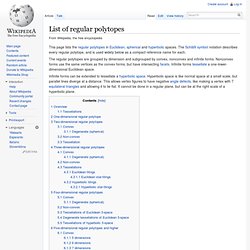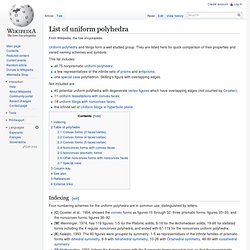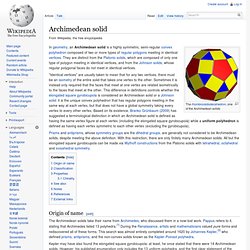

List of regular polytopes. This page lists the regular polytopes in Euclidean, spherical and hyperbolic spaces.

The Schläfli symbol notation describes every regular polytope, and is used widely below as a compact reference name for each. Overview[edit] This table shows a summary of regular polytope counts by dimension. There are no nonconvex Euclidean regular tessellations in any number of dimensions. Tessellations[edit] The classical convex polytopes may be considered tessellations, or tilings, of spherical space.
One-dimensional regular polytope[edit] There is only one polytope in 1 dimensions, whose boundaries are the two endpoints of a line segment, represented by the empty Schläfli symbol {}. Two-dimensional regular polytopes[edit] The two-dimensional polytopes are called polygons. Usually only convex polygons are considered regular, but star polygons, like the pentagram, can also be considered regular. Convex[edit] The Schläfli symbol {p} represents a regular p-gon. Degenerate (spherical)[edit] Non-convex[edit] and.
List of uniform polyhedra. Uniform polyhedra and tilings form a well studied group.

They are listed here for quick comparison of their properties and varied naming schemes and symbols. This list includes: Not included are: Indexing[edit] Four numbering schemes for the uniform polyhedra are in common use, distinguished by letters: [C] Coxeter et al., 1954, showed the convex forms as figures 15 through 32; three prismatic forms, figures 33–35; and the nonconvex forms, figures 36–92. Table of polyhedra[edit] The convex forms are listed in order of degree of vertex configurations from 3 faces/vertex and up, and in increasing sides per face. Convex forms (3 faces/vertex)[edit] Making the Polyhedra. Introduction -- Making the Modules -- Making the Polyhedra -- Jim's Origami Page These are notes on some of the polyhedra that you can make with the basic modules (triangle, square, pentagon, hexagon).

The ones with octagons and decagons can be made with similar modules, but they're pretty flimsy, so I haven't include them. Each module is an edge of the polyhedron. The notation is as follows --- if it says ``sq--tr'', then it means to fold a module with a 90-degree angle on one side, and a 60-degree angle on the other. That edge will be used for places on the polyhedron where a triangle meets a square. Coloring is a matter of taste. TetrahedronOctahedronIcosahedronCubeDodecahedronTruncated TetrahedronTruncated OctahedronTruncated IcosahedronCuboctahedronRhombicuboctahedronIcosidodecahedronRhombicosidodecahedronSnub CubeSnub Dodecahedron Jim Plank --- Jim's Origami Page. Archimedean solid. "Identical vertices" are usually taken to mean that for any two vertices, there must be an isometry of the entire solid that takes one vertex to the other.

Sometimes it is instead only required that the faces that meet at one vertex are related isometrically to the faces that meet at the other. This difference in definitions controls whether the elongated square gyrobicupola is considered an Archimedean solid or a Johnson solid: it is the unique convex polyhedron that has regular polygons meeting in the same way at each vertex, but that does not have a global symmetry taking every vertex to every other vertex. Based on its existence, Branko Grünbaum (2009) has suggested a terminological distinction in which an Archimedean solid is defined as having the same vertex figure at each vertex (including the elongated square gyrobicupola) while a uniform polyhedron is defined as having each vertex symmetric to each other vertex (excluding the gyrobicupola). Icosidodecahedron. In geometry, an icosidodecahedron is a polyhedron with twenty triangular faces and twelve pentagonal faces.

An icosidodecahedron has 30 identical vertices, with two triangles and two pentagons meeting at each, and 60 identical edges, each separating a triangle from a pentagon. As such it is one of the Archimedean solids and more particularly, a quasiregular polyhedron. An icosidodecahedron has icosahedral symmetry, and its first stellation is the compound of a dodecahedron and its dual icosahedron, with the vertices of the icosahedron located at the midpoints of the edges of either. Its dual polyhedron is the rhombic triacontahedron. An icosidodecahedron can be split along any of six planes to form a pair of pentagonal rotundae, which belong among the Johnson solids.